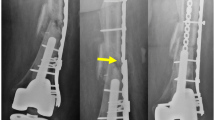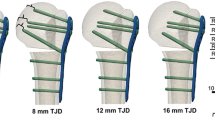Abstract
Internal fixation of bone fractures using plates and screws involves many choices—implant type, material, sizes, and geometric configuration—made by the surgeon. These decisions can be important for providing adequate stability to promote healing and prevent implant mechanical failure. The purpose of this study was to develop mathematical models of the relationships between fracture fixation construct parameters and resulting 3D biomechanics, based on parametric computer simulations. Finite element models of hundreds of different locked plate fixation constructs for midshaft diaphyseal fractures were systematically assembled using custom algorithms, and axial, torsional, and bending loadings were simulated. Multivariate regression was used to fit response surface polynomial equations relating fixation design parameters to outputs including maximum implant stresses, axial and shear strain at the fracture site, and construct stiffness. Surrogate models with as little as three regressors showed good fitting (R 2 = 0.62–0.97). Inner working length was the strongest predictor of maximum plate and screw stresses, and a variety of quadratic and interaction terms influenced resulting biomechanics. The framework presented in this study can be applied to additional types of bone fractures to provide clinicians and implant designers with clinical insight, surgical optimization, and a comprehensive mathematical description of biomechanics.





Similar content being viewed by others
Abbreviations
- L plate :
-
Length of plate
- d gap :
-
Fracture gap size
- N screws :
-
Number of screws
- L inner :
-
Working length between inner screws
- L outer :
-
Working length between outer screws
- E implant :
-
Implant material elastic modulus
- σ plate_max :
-
Max von Mises stress of plate
- σ screw_max :
-
Max von Mises stress of screw
- k axial :
-
Axial stiffness of the fracture fixation construct
- k torsion :
-
Torsional stiffness of the fracture fixation construct
- k bending :
-
Bending stiffness of the fracture fixation construct
- ε axial :
-
Interfragmentary axial strain
- ε shear :
-
Interfragmentary shear strain
References
Augat, P., J. Burger, S. Schorlemmer, T. Henke, M. Peraus, and L. Claes. Shear movement at the fracture site delays healing in a diaphyseal fracture model. J. Orthop. Res. 21:1011–1017, 2003.
Bah, M. T., J. Shi, M. O. Heller, Y. Suchier, F. Lefebvre, P. Young, L. King, D. G. Dunlop, M. Boettcher, E. Draper, and M. Browne. Inter-subject variability effects on the primary stability of a short cementless femoral stem. J. Biomech. 48:1032–1042, 2015.
Bonyun, M., A. Nauth, K. A. Egol, M. J. Gardner, P. J. Kregor, M. D. McKee, P. R. Wolinsky, and E. H. Schemitsch. Hot topics in biomechanically directed fracture fixation. J. Orthop. Trauma 28:S32–S35, 2014.
Bottlang, M., J. Doornink, D. C. Fitzpatrick, and S. M. Madey. Far cortical locking can reduce stiffness of locked plating constructs while retaining construct strength. J. Bone Jt. Surg. 91:1985–1994, 2009.
Bottlang, M., J. Doornink, T. J. Lujan, D. C. Fitzpatrick, J. L. Marsh, P. Augat, B. von Rechenberg, M. Lesser, and S. M. Madey. Effects of construct stiffness on healing of fractures stabilized with locking plates. J. Bone Jt. Surg. 92:12–22, 2010.
Casha, A. R., L. Camilleri, A. Manché, R. Gatt, D. Attard, M. Gauci, M.-T. Camilleri-Podesta, and J. N. Grima. External rib structure can be predicted using mathematical models: An anatomical study with application to understanding fractures and intercostal muscle function. Clin. Anat. 28:512–519, 2015.
Claes, L. Biomechanical principles and mechanobiologic aspects of flexible and locked plating. J. Orthop. Trauma 25:S4–S7, 2011.
Cowin, S. C., and S. B. Doty. Tissue mechanics. New York: Springer, p. 357, 2007.
Duda, G. N., F. Mandruzzato, M. Heller, J.-P. Kassi, C. Khodadadyan, and N. P. Haas. Mechanical conditions in the internal stabilization of proximal tibial defects. Clin. Biomech. 17:64–72, 2002.
Egol, K. A., C. E. Capriccioso, S. R. Konda, N. C. Tejwani, F. A. Liporace, J. D. Zuckerman, and R. I. Davidovitch. Cost-effective trauma implant selection. J. Bone Jt. Surg. 96:e189, 2014.
Egol, K. A., E. N. Kubiak, E. Fulkerson, F. J. Kummer, and K. J. Koval. Biomechanics of locked plates and screws. J. Orthop. Trauma Sept. 2004(18):488–493, 2004.
Elkins, J., J. L. Marsh, T. Lujan, R. Peindl, J. Kellam, D. D. Anderson, and W. Lack. Motion predicts clinical callus formation: construct-specific finite element analysis of supracondylar femoral fractures. J. Bone Joint Surg. Am. 98:276–284, 2016.
Ellis, T., C. A. Bourgeault, and R. F. Kyle. Screw Position Affects Dynamic Compression Plate Strain in an In Vitro Fracture Model. J. Orthop. Trauma 15:333–337, 2001.
Fang, K.-T., R. Li, and A. Sudjianto. Design and modeling for computer experiments. New York: Chapman & Hall/CRC Press, pp. 20–24, 2006.
Gardner, M. J., J. M. Evans, and R. P. Dunbar. Failure of Fracture Plate Fixation. J. Am. Acad. Orthop. Surg. 17:647–657, 2009.
Klein, P., H. Schell, F. Streitparth, M. Heller, J.-P. Kassi, F. Kandziora, H. Bragulla, N. P. Haas, and G. N. Duda. The initial phase of fracture healing is specifically sensitive to mechanical conditions. J. Orthop. Res. Off. Publ. Orthop. Res. Soc. 21:662–669, 2003.
MacLeod, A. R., A. H. R. W. Simpson, and P. Pankaj. Age-related optimisation of screw placement for reduced loosening risk in locked plating. J. Orthop. Res. Off. Publ. Orthop. Res. Soc. 2016. doi:10.1002/jor.23193.
Märdian, S., K.-D. Schaser, G. N. Duda, and M. Heyland. Working length of locking plates determines interfragmentary movement in distal femur fractures under physiological loading. Clin. Biomech. 30:391–396, 2015.
Moazen, M., A. C. Jones, A. Leonidou, Z. Jin, R. K. Wilcox, and E. Tsiridis. Rigid versus flexible plate fixation for periprosthetic femoral fracture—Computer modelling of a clinical case. Med. Eng. Phys. 34:1041–1048, 2012.
Morgan, E. F., K. T. S. Palomares, R. E. Gleason, D. L. Bellin, K. B. Chien, G. U. Unnikrishnan, and P. L. Leong. Correlations between local strains and tissue phenotypes in an experimental model of skeletal healing. J. Biomech. 43:2418–2424, 2010.
Nassiri, M., B. MacDonald, and J. M. O’Byrne. Computational modelling of long bone fractures fixed with locking plates – How can the risk of implant failure be reduced? J. Orthop. 10:29–37, 2013.
Oh, J.-K., D. Sahu, Y.-H. Ahn, S.-J. Lee, S. Tsutsumi, J.-H. Hwang, D.-Y. Jung, S. M. Perren, and C.-W. Oh. Effect of fracture gap on stability of compression plate fixation: A finite element study. J. Orthop. Res. 28:462–467, 2010.
Perren, S. M. Evolution of the internal fixation of long bone fractures. The scientific basis of biological internal fixation: choosing a new balance between stability and biology. J. Bone Joint Surg. Br. 84:1093–1110, 2002.
Prendergast, P. J., R. Huiskes, and K. Søballe. Biophysical stimuli on cells during tissue differentiation at implant interfaces. J. Biomech. 30:539–548, 1997.
Ruedi, T. P., W. M. Murphy, et al. AO principles of fracture management. New York: Thieme Medical Publishers, pp. 292–294, 2007.
SAS Institute. SAS/IML 9.3 User’s Guide. SAS Institute, 2011, pp. 6340–6475 at https://support.sas.com/documentation/cdl/en/imlug/64248/PDF/default/imlug.pdf
Simpson, T. W., A. J. Booker, D. Ghosh, A. A. Giunta, P. N. Koch, and R.-J. Yang. Approximation methods in multidisciplinary analysis and optimization: a panel discussion. Struct. Multidiscip. Optim. 27:302–313, 2004.
Smith, W. R., B. H. Ziran, J. O. Anglen, and P. F. Stahel. Locking plates: tips and tricks. J. Bone Jt. Surg. 89:2298–2307, 2007.
Stoffel, K., U. Dieter, G. Stachowiak, A. Gächter, and M. S. Kuster. Biomechanical testing of the LCP – how can stability in locked internal fixators be controlled? Injury 34(Supplement 2):11–19, 2003.
Wagner, M. General principles for the clinical use of the LCP. Injury 34(Supplement 2):31–42, 2003.
Acknowledgments
This project is funded, in part, under a grant with the Pennsylvania Department of Health using Tobacco CURE Funds. Project no. S-15-196L was supported by AO Foundation, Switzerland. Additional support was received from the National Center for Advancing Translational Sciences, Grant KL2 TR000126. Fracture fixation plates and screws were donated by Depuy Synthes. Disclosure: H.W. and V.M.C. have no conflicts of interest to disclose. G.S.L. has received implants and CAD files for research as PI from Depuy-Synthes. J.S.R. is a speaker for product related instructional courses for Smith and Nephew, and is a consultant for Depuy-Synthes.
Author information
Authors and Affiliations
Corresponding author
Additional information
Associate Editor Peter E. McHugh oversaw the review of this article.
Electronic Supplementary Material
Below is the link to the electronic supplementary material.
Rights and permissions
About this article
Cite this article
Wee, H., Reid, J.S., Chinchilli, V.M. et al. Finite Element-Derived Surrogate Models of Locked Plate Fracture Fixation Biomechanics. Ann Biomed Eng 45, 668–680 (2017). https://doi.org/10.1007/s10439-016-1714-3
Received:
Accepted:
Published:
Issue Date:
DOI: https://doi.org/10.1007/s10439-016-1714-3




